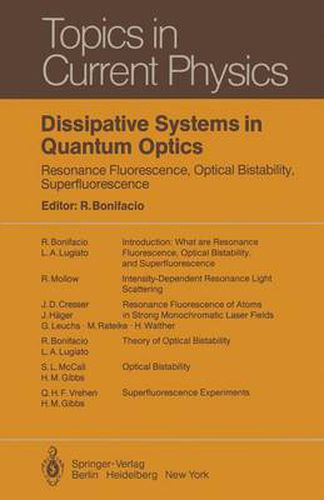Readings Newsletter
Become a Readings Member to make your shopping experience even easier.
Sign in or sign up for free!
You’re not far away from qualifying for FREE standard shipping within Australia
You’ve qualified for FREE standard shipping within Australia
The cart is loading…






This title is printed to order. This book may have been self-published. If so, we cannot guarantee the quality of the content. In the main most books will have gone through the editing process however some may not. We therefore suggest that you be aware of this before ordering this book. If in doubt check either the author or publisher’s details as we are unable to accept any returns unless they are faulty. Please contact us if you have any questions.
In studying the radiation-matter interaction, one can take two different approaches. The first is typical of spectroscopy: one considers the interaction between radi ation and a single atom, i. e. , one studies those phenomena in which the presence of other atoms is irrelevant. The other attitude consists, in contrast, in studying those phenomena which arise just from the simultaneous presence of many atoms. In fact, all the atoms interact with the same electromagnetic field; under suitable conditions, this situation creates strong atom-atom correlations, which in turn give rise to a cooperative behavior of the system as a whole. Cooperative means that the overall behavior is quite different from the superposition of the effects arising from single atoms and is completely unpredictable if one neglects the coup ling between the atoms induced by their common electromagnetic field. This book contains five complete and up-to-date contributions on the theory and experiments of three coherence effects in radiation-matter interaction: resonance fluorescences, optical bistability, and superfluorescence. They have raised in creasing interest in recent years from both a fundamental and an applicative view point. Even if their phenomenology appears completely different, these effects be long in the same book because they are striking examples of open systems driven far from thermal equilibrium, as those considered in Haken’s synergetics and in Prigogine’s theory of dissipative structures. This aspect is discussed in the in troducting chapter, in which we outline the basic physics and the essential features which unify these three effects.
$9.00 standard shipping within Australia
FREE standard shipping within Australia for orders over $100.00
Express & International shipping calculated at checkout
This title is printed to order. This book may have been self-published. If so, we cannot guarantee the quality of the content. In the main most books will have gone through the editing process however some may not. We therefore suggest that you be aware of this before ordering this book. If in doubt check either the author or publisher’s details as we are unable to accept any returns unless they are faulty. Please contact us if you have any questions.
In studying the radiation-matter interaction, one can take two different approaches. The first is typical of spectroscopy: one considers the interaction between radi ation and a single atom, i. e. , one studies those phenomena in which the presence of other atoms is irrelevant. The other attitude consists, in contrast, in studying those phenomena which arise just from the simultaneous presence of many atoms. In fact, all the atoms interact with the same electromagnetic field; under suitable conditions, this situation creates strong atom-atom correlations, which in turn give rise to a cooperative behavior of the system as a whole. Cooperative means that the overall behavior is quite different from the superposition of the effects arising from single atoms and is completely unpredictable if one neglects the coup ling between the atoms induced by their common electromagnetic field. This book contains five complete and up-to-date contributions on the theory and experiments of three coherence effects in radiation-matter interaction: resonance fluorescences, optical bistability, and superfluorescence. They have raised in creasing interest in recent years from both a fundamental and an applicative view point. Even if their phenomenology appears completely different, these effects be long in the same book because they are striking examples of open systems driven far from thermal equilibrium, as those considered in Haken’s synergetics and in Prigogine’s theory of dissipative structures. This aspect is discussed in the in troducting chapter, in which we outline the basic physics and the essential features which unify these three effects.